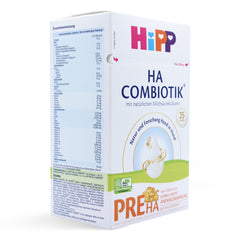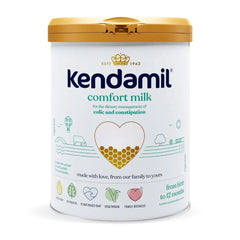What Is Hypoallergenic Baby Formula and Why It Matters
Responsible parents prioritize their child's nutrition when choosing among different formulas. Parents seek formulas that are ideal for their babies' specific needs. Today, allergic reactions or intolerance to certain ingredients is common among infants. Using hypoallergenic baby formula helps address these issues effectively.
Parents need to understand "what is hypoallergenic formula?" and what advantages it offers. Hypoallergenic baby formula is designed for babies with specific sensitivities. Often, hypoallergenic formula works best for children sensitive to cow's milk protein.
Parents frequently notice specific symptoms in their babies and quickly consult pediatricians. The doctor examines the child and may recommend a different diet. Hypoallergenic baby formula is an excellent alternative for babies with sensitive digestion. Many children are allergic to milk, dairy products, and formulas containing them.
High-quality formula for milk allergies is designed to minimize risks. The formula supports baby growth and development while reducing discomfort.
Understanding Different Types of Hypoallergenic Formulas
Today, hypoallergenic baby formulas are reaching new levels of quality and effectiveness. Parents prefer high-quality products for feeding their babies. Hypoallergenic products contain necessary nutrients and suit sensitive digestive systems. Children can consume these formulas without signs of allergies or intolerance.
Understanding hypoallergenic options helps parents make informed choices for their babies. Several different types of hypoallergenic baby formulas are available today. It's important to understand "what does hypoallergenic formula mean?" and why parents choose it.
Here are the main types of hypoallergenic formulas:
-
Extensively Hydrolyzed Formulas. These formulas are excellent choices for many parents. They use cow's milk protein that has been extensively broken down. For children with sensitive systems, these formulas are ideal due to reduced allergenic potential. Most parents choose these formulas for hypoallergenic feeding. A prime example is Aptamil Pepti Stage 2 for children from six months.
-
Amino Acid-Based Formulas. These formulas contain no cow's milk protein and are excellent for severe cases. The formula is often recommended for severe allergic reactions in babies. These formulas cost more and are recommended exclusively by medical professionals.
-
Partially Hydrolyzed Formulas. Formulas for dairy allergies can be partially hydrolyzed. These formulas contain cow's milk protein broken down into smaller peptides. The formula remains gentle but suits babies with mild allergic reactions. Parents frequently use these formulas for babies with digestive issues. A good example is Kendamil Comfort for children from 0 to 12 months. This formula helps with colic, bloating, and promotes good digestion.
What Ingredients Make a Formula Hypoallergenic?
Organic Life Start offers high-quality European brands for baby feeding. Natural composition, hydrolyzed proteins, and amino acids make these formulas excellent choices. Parents choose formulas according to their child's specific needs. Hypoallergenic baby formulas are excellent choices for many babies.
Children prone to allergic reactions cannot tolerate regular formulas. Parents choose baby formulas designed for allergies and digestive sensitivity. Today, it's essential to understand why certain formulas become safe for sensitive babies.
Here are the primary processing methods that make baby formulas hypoallergenic:
-
Hydrolyzed Proteins. Cow's milk protein is broken down during the manufacturing process. The protein is broken into small peptides, making the formula more suitable for sensitive children. Formulas can be partially or extensively hydrolyzed depending on nutritional needs and allergy severity.
-
Free Amino Acids. Free amino acids serve as the main protein source for specialized nutrition. This process helps reduce allergic reactions in babies. Free amino acids are the best choice for children with severe allergic reactions.
-
Modified Milk Components. Parents should understand "what is hypoallergenic baby formula?" Manufacturers can modify milk components or remove them completely. Lactose content can be reduced for complete nutrition. These formulas are often used by parents whose children are prone to sensitivities.
-
Alternative Protein Sources. Some hypoallergenic formulas use proteins from sources other than cow's milk, such as goat milk, rice protein, or soy protein isolate. These alternative proteins may be better tolerated by babies who have specific sensitivities to cow's milk proteins. However, parents should consult with their pediatrician before switching to alternative protein sources, as some babies may also be allergic to these ingredients.
Can Babies Be Allergic to Hypoallergenic Formula?

Many parents wonder "can babies be allergic to hypoallergenic formula?" Usually, children with sensitive digestion respond well to hypoallergenic formulas. However, in rare cases, complications may occur with certain symptoms. Crying, vomiting, and diarrhea are main signs of allergic reactions.
Parents may notice rashes and difficulty breathing during examination. When these symptoms occur, consult a doctor promptly to change formulas. Switching to different formulas will improve the baby's digestion and health. Babies can be allergic to hypoallergenic formulas, requiring formula changes.
Here's why reactions occur:
-
Residual Proteins. Hypoallergenic baby formulas have reduced lactose content or no milk at all. However, partially hydrolyzed formulas contain larger protein fragments that can cause allergies. Even minimal content can trigger allergic reactions in sensitive babies. The smallest traces of proteins can cause reactions requiring prompt treatment.
-
Immune System Response. Some children may not tolerate hypoallergenic formulas due to immune reactions. Parents usually choose amino acid-based formulas to restore proper nutrition. Gradually introducing new formulas helps avoid many symptoms.
-
Other Ingredients. Reactions can occur to other ingredients in hypoallergenic formulas, even without lactose. While hypoallergenic formula milk is excellent for many children, bodies may react to other ingredients. These can include soy or certain oils.
When and How to Introduce Hypoallergenic Formula to Your Baby
Allergies and lactose intolerance are present in many babies. Parents begin worrying when they notice specific symptoms. Symptoms may indicate allergic reactions requiring a formula change. Children are commonly allergic to cow's milk protein and lactose.
In these cases, children experience digestive discomfort, bloating, and gas. In severe cases, allergic reactions such as rashes and blood in stool may occur. Even one symptom may indicate severe lactose intolerance. This makes it essential to consult a doctor promptly.
Many parents ask "Can I give my baby hypoallergenic formula?" Usually, hypoallergenic formulas are excellent choices for sensitive digestion. Consultation with a doctor is mandatory. The consultation helps identify factors causing allergic reactions and intolerance.
The pediatrician will conduct testing and examine the baby based on symptoms parents report. The pediatrician can recommend high-quality formulas for gradual transitions. Often, pediatricians recommend either extensively hydrolyzed or amino acid-based formulas.
Parents need to understand how to make smooth transitions to different formulas. Switching to hypoallergenic formulas for babies takes time and patience. Initially, mix the old formula with the new formula in a four-to-one ratio. After a few days, introduce a 50-50 mixture and watch the baby's reaction.
Careful monitoring and following guidelines help avoid consequences. After a week, parents can fully transition the child to the new formula. Tracking changes helps understand correct transitions and provides feedback opportunities.
Popular Hypoallergenic Baby Formulas and What to Look For

Parents should evaluate quality hypoallergenic formulas carefully. A good list of hypoallergenic formulas help minimize allergic reaction symptoms. Today, parents should pay attention to wholesome ingredients and labels. Labels help understand the amount of quality ingredients and their benefits.
Certification plays a key role in meeting proper standards. Many brands such as HiPP, Holle, and Kendamil are reliable and certified. Here are well-known hypoallergenic baby formulas:
-
HiPP HA. Features 86% hydrolyzed whey protein with prebiotics and probiotics. Uses lactose, avoids corn syrup and artificial additives.
-
Enfamil Nutramigen. #1 pediatrician-recommended for cow's milk allergies. Contains extensively hydrolyzed proteins with DHA, though some versions have corn syrup.
-
Similac Alimentum. Avoids carrageenan and corn syrup. Uses hydrolyzed casein protein for severe allergies and colic-related sensitivities.
-
Bobbie Organic Gentle. USDA organic certified with partially hydrolyzed whey proteins. Uses organic lactose and grass-fed milk, earning Clean Label Purity Award.
-
Kendamil. European brand following strict EU standards. Kendamil is FDA-approved for US distribution. Both feature cleaner ingredients and avoid common US formula additives.
Benefits of Hypoallergenic Formulas Beyond Allergy Management
Good quality hypoallergenic formulas offer many benefits for babies. Hypoallergenic baby formulas contribute to overall child health. Many parents choose hypoallergenic formulas without diagnosed allergies. These formulas are excellent choices for children prone to allergic reactions. The right choice helps strengthen baby health.
Here are key benefits of hypoallergenic formulas:
-
Improved Digestion. These formulas contain easily digested proteins for better absorption and digestion. The formula is best for reducing uncomfortable symptoms in babies. Hypoallergenic formulas help reduce bloating and gas while providing comfort.
-
Reduced Colic. Formulas for allergies help reduce colic and gas in babies. Minimized lactose content or its absence makes digestion easier. Parents feel more relaxed due to their baby's restful sleep.
-
Support for Sensitive Stomachs. The most significant advantage of hydrolyzed formulas is support for sensitive stomachs. High-quality ingredients promote easier digestion and reduce spit-up. These formulas are ideal for babies with severe allergic reactions and digestive sensitivities.
Organic Life Start is committed to providing accurate, reliable, and trustworthy information to parents and caregivers. We carefully choose credible sources and follow a meticulous fact-checking process to uphold the highest standards in infant nutrition and parenting advice. To learn more about our dedication to accuracy, please explore our editorial guidelines.
Link To Sources










